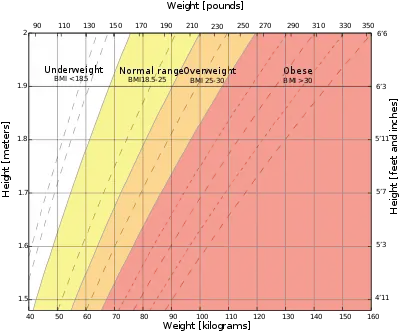Hara hachi bun me (腹八分目) (also spelled hara hachi bu, and sometimes misspelled hari hachi bu) is a Confucian[1] teaching that instructs people to eat until they are 80 percent full.[2] The Japanese phrase translates to, "Eat until you are eight parts (out of ten) full",[2] or "belly 80 percent full".[3]
Okinawans

As of the early 21st century, Okinawans in Japan continue practicing hara hachi bun me.[2] They consume about 1,800[3] to 1,900 kilo-calories per day.[4] Their elders' typical body mass index (BMI) is about 18 to 22, compared to a typical BMI of 26 or 27 for adults over 60 in the United States.[5] Okinawa has the world's highest proportion of centenarians, at approximately 50 per 100,000 people.[6]
Biochemist Clive McCay, a professor at Cornell University in the 1930s, reported that significant calorie restriction prolonged life in laboratory animals.[7][8] Authors Bradley and Craig Wilcox and Makoto Suzuki believe that hara hachi bun me may act as a form of calorie restriction, thus extending practitioners' life expectancy. They believe hara hachi bun me assists in keeping the average Okinawan's BMI low, and this is thought to be due to the delay in the stomach stretch receptors that help signal satiety. The result of not practising hara hachi bun me is a constant stretching of the stomach which in turn increases the amount of food needed to feel full.[2]
In other cultures
The approach to eating of hara hachi bun me is also found in other cultures.
China
The teaching is Confucian,[9] a belief system dating back to the 5th century BCE China. A similar saying to the Confucian one is found in Traditional Chinese Medicine: "Chīfàn qī fēn bǎo, sān fēn han" (吃飯七分飽、三分寒, "only eat 70 percent full, and wear 30 percent less.")[10]
India
The principle also appears in Ayurvedic medicine, dating back to the 4th century BCE, where "you should fill one third of the stomach with liquid, another third with food, and leave the rest empty."[10]
Influence
Zen
In the 1965 book Three Pillars of Zen, the author quotes Hakuun Yasutani in his lecture for zazen beginners as telling his students about the book Zazen Yojinki (Precautions to Observe in Zazen), written circa 1300, which advises practitioners to eat about two-thirds of their capacity. Yasutani advises his students to eat only eighty percent of their capacity, and he repeats a Japanese proverb: "eight parts of a full stomach sustain the man; the other two sustain the doctor".[11]
American culture
Hara hachi bun me was popularized in the United States by a variety of modern books on diet and longevity.[12][13]
See also
References
- Buettner, Dan (2008). The Blue Zones. National Geographic Society. ISBN 978-1-4262-0274-2.
Footnotes
- ↑ Buettner, pp. 7, 227
- 1 2 3 4 Willcox BJ; Willcox DC; Suzuki M (2002). The Okinawa Program : How the World's Longest-Lived People Achieve Everlasting Health And How You Can Too. Three Rivers Press. pp. 86–87. ISBN 978-0-609-80750-7.
- 1 2 Grossman, Terry (2005). "Latest advances in antiaging medicine". The Keio Journal of Medicine. 54 (2): 85–94. doi:10.2302/kjm.54.85. PMID 16077258.
- ↑ Beuttner, p. 233
- ↑ Smolin LA; Grosvenor MB (2004). Basic Nutrition. Infobase Publishing. p. 134. ISBN 0-7910-7850-7.
- ↑ "Okinawa's Centenarians". The Okinawa Centenarian Study. Retrieved 21 April 2013.
- ↑ Ingram, DK; et al. (2004). "Development of calorie restriction mimetics as a prolongevity strategy". Annals of the New York Academy of Sciences. Wiley-Blackwell. 1019 (1): 412–423. Bibcode:2004NYASA1019..412I. doi:10.1196/annals.1297.074. PMID 15247056. S2CID 35738969.
- ↑ "Clive McCay papers, 1920-1967" (PDF). Cornell University Library. Retrieved June 1, 2011.
- ↑ Buettner, pp. 7, 227
- 1 2 Andreas Michalsen (8 August 2019). The Natural Prescription: A Doctor's Guide to the Science of Natural Medicine. Hodder & Stoughton. pp. 82–. ISBN 978-1-5293-6656-3.
- ↑ Kapleau, Philip (1989). The Three pillars of Zen: teaching, practice, and enlightenment. New York: Anchor Books. pp. 43–44. ISBN 0-385-26093-8.
- ↑ Buettner, pp. 83, 96, 103, 233
- ↑ Beckerman, James (2011). The Flex Diet. Touchstone. pp. 162–163. ISBN 978-1-4391-5569-1.